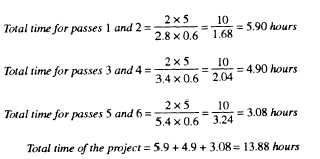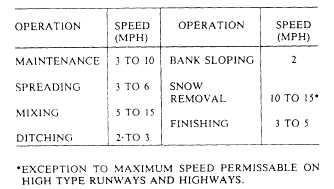Before making any cuts on a project, review the
project grade hub stakes (blue tops) to note their location
and how much you will have to cut or fill.
NOTE: Compaction of the surface must be done
before finish grading can start. When you finish
grading, it is better to cut 1/2 to 1 inch than to fill.
A technique used when performing blue topping
operations is to divide the project into sections, working
one section to final grade at a time. After the first section
is to grade, you now have a reference point to start from
to grade the other sections. As with any earthmoving
equipment, it is best to have a level starting point.
When working each section, do not let the material
build up into piles that the grader will have to run over.
Windrow the material to the end or off the section and
have a loader pickup the excess material and move it.
If there is room, the excess material can be windrowed
off the project for later removal.
When cutting, drag the blade over the top of the hub
stake. Final grade is reached when the blade skims the
top of the hub stake. Do not cut too deep and knock the
hub stake out of the ground. When several passes are
required to achieve final grade, the “cut boss” should
clean off the top of the stakes so you can see them for
your next pass.
Grader Estimates
A part of planning a construction project is
estimating how long it will take to complete a
construction activity.
A work-output formula for
preparing preliminary estimates for grader operations is
as follows:
W h e re
Total time =
P =
D =
S
=
E =
Hours required to complete a grader
operation
Number of passes (P) the grader
must take to complete the operation
Distance (D) traveled in each
pass expressed in miles
Speed (S) expressed in miles per hour
Grader efficiency (E) factor
The most difficult factor to estimate is the speed of
the grader. As work progresses on a construction
10-15
activity, conditions may require that the speed estimates
of the grader be increased or decreased. A work output
is computed for each operation that is performed at a
different rate of speed. The total time of each operation
for each different speed is added together to compute the
total time of the grader operation. Table 10-1 lists the
speeds normally used in various grader operations.
The grader efficiency (E) factor takes into account
the fact that a 60-minute work hour rarely is attained.
Efficiency varies, depending upon supervision, operator
skill, maintenance requirements, and site conditions. A
value of 60 percent is average, computed in decimal
form as 0.6. The efficiency factor can be adjusted on
each job.
Example problem:
Five miles of gravel road is to be leveled and
reshaped by using a grader with a 12-foot blade. Six
passes are estimated to complete the leveling and
reshaping operation.
The type of material permits
passes 1 and 2 to be performed in second gear at 2.8
mph, passes 3 and 4 in third gear at 3.4 mph, and passes
5 and 6 in fourth gear at 5.4 mph. The efficiency factor
for the job is 60 percent.
Calculate how long it will take to complete the job.
Always round your answer to the next higher
number. In this case, 13.88 is rounded to 14 hours.
Table 10-1.-Approximate Speed Ranges Used in Various
Grader Operations




